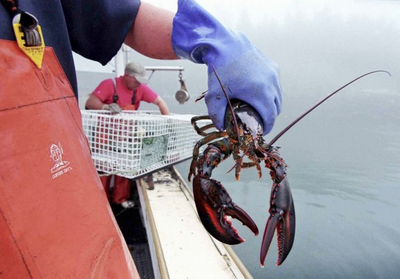
California has its raisins, Florida its oranges and Vermont has maple syrup. Now, Maine’s lobster industry is trying to market its brand more broadly and increase sales of the state’s best-known seafood.
The annual marketing budget for lobsters will increase more than six-fold to $2.2 million under a law taking effect in October, launching what some call a new era for the industry. The goal is to get more people in the U.S. and abroad to buy more Maine lobster and related products at restaurants and in stores, while increasing prices to help fishermen boost their incomes.
Marketing was little more than an afterthought in the lobster industry before the 1990s, when the annual catch was typically 20 million pounds or less. That changed in 1991 with the creation of the industry-funded Maine Lobster Promotion Council, a small operation whose budget this past year was around $370,000.
But the lobster harvest has ballooned to previously unimagined levels — a record 127 million pounds was hauled in Maine last year— and prices have remained low since tanking when the global economy went sour in 2008. Fishermen received $2.69 a pound on average for their catch last year, a nearly 40 percent drop since 2007 and the lowest price since 1994. So lobstermen for the most part agree that the industry needs to somehow better market its product.
“If this thing works right,” said John Sauve, whose Portland marketing firm was hired to guide the process, “the headlines will go from there being a glut of supply to a glut of demand.”
Maine is already well-known for its lobsters. Still, the industry might have some inherent hurdles to overcome to increase sales, said Mark Lang, a professor of food marketing at Saint Joseph’s University in Philadelphia. People don’t usually think “lobster” when asking themselves what they should fix for dinner, he said. They also perceive it to be expensive and hard to prepare.
But there are plenty of positive associations with Maine lobsters, such as cold ocean waters, the nostalgia of how it’s caught and it being an American product, he said.
“There are a lot of nice connotations attached to lobster, so they’re in a good starting place,” he said. “They’re not trying to fix something that’s bad.”
There are dozens of marketing initiatives nationwide for food products as diverse as raisins, cranberries, milk, beef, pork and citrus.
The key to a successful marketing campaign is to show how a product differs from others in a way that’s important to customers, Lang said. That difference might be its flavor, how it can be prepared or its sustainability.
“It gives the customer a reason why to select a product over alternatives,” he said.
For Maine’s campaign, an 11-member board will create a three-year marketing plan with a detailed plan and budget in the coming months, said Sauve, managing director of the Food and Wellness Group marketing firm in Portland. By law, the plan has to be presented to the Legislature in January.
The board, called the Maine Lobster Marketing Collaborative, replaces the smaller council. It will be funded through increases in license fees for fishermen and lobster dealers and processors. Its budget is projected to be $750,000 for the current fiscal year, $1.5 million next year and $2.2 million after that.
The members of the collaborative — four lobstermen, three lobster wholesalers and dealers, two members of the public, and state agency representatives — will devise strategies and tactics with Sauve’s help on marketing lobsters to consumers, restaurants and retailers.
The campaign is long overdue, said Patrice McCarron, executive director of the Maine Lobstermen’s Association.
The Maine lobster competes with a lot of other foods, including the same lobster species that’s caught in Canada and spiny lobsters from the Caribbean and other warm-water locations, she said. Like Maine’s harvest, Canada’s lobster catch has also surged in recent years.
“You compete lobster to lobster. You compete lobster to seafood,” she said. “As you go down the food chain, you compete against other proteins.”
Copyright 2013 The Associated Press. All rights reserved. This material may not be published, broadcast, rewritten or redistributed.





